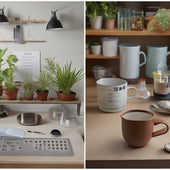
Why Rooftop Gardens Are Good for the Planet
Share
By incorporating rooftop gardens into urban landscapes, you're not only mitigating the urban heat island effect, which can make cities up to 10°F warmer than rural areas, but also supporting local biodiversity, improving air quality by absorbing pollutants, and reducing stormwater runoff. Additionally, rooftop gardens sequester carbon and offset emissions, creating a multifaceted solution for a healthier planet. As you explore the ways rooftop gardens benefit the environment, you'll uncover even more advantages of integrating green spaces into urban planning, from enhancing ecosystem resilience to increasing property value.
Urban Heat Island Mitigation
By incorporating rooftop gardens into urban planning, you can significantly reduce the urban heat island effect. This phenomenon occurs when built-up areas absorb and retain heat, causing temperatures to rise by as much as 10°F (5.6°C) higher than in surrounding rural areas. Such temperature increases can lead to various issues, including increased energy consumption, heat-related illnesses, and mortality.
Rooftop gardens, as a form of green infrastructure, can help mitigate the urban heat island effect by providing evaporative cooling through plant transpiration and shading. City planning strategies can include zoning regulations, incentivizing building owners, and providing educational resources to encourage the integration of rooftop gardens. For example, cities can offer tax breaks or density bonuses to buildings with rooftop gardens.
Furthermore, urban planners can design buildings with green roofs in mind, ensuring structural integrity and accessibility. By integrating rooftop gardens into city planning, a more sustainable and resilient urban environment can be created. This approach not only helps in reducing the urban heat island effect but also improves the quality of life for urban dwellers.
Biodiversity and Ecosystem Support
Rooftop gardens become thriving ecosystems, providing habitats for a diverse range of plant and animal species, as you intentionally design and manage them to support local biodiversity. By creating a wildlife habitat, you're contributing to the preservation of native species and supporting the local food chain. Green infrastructure benefits extend beyond your rooftop, as these ecosystems can connect fragmented habitats, allowing species to migrate and interact.
| Ecosystem Benefits | Rooftop Garden Strategies |
|---|---|
| Habitat creation for native species | Incorporate native plants, shrubs, and trees |
| Food source provision for pollinators | Plant pollinator-friendly flowers and herbs |
| Shelter and breeding grounds for urban wildlife | Incorporate features like birdhouses, bee hotels, and insect-friendly plants |
| Corridor creation for species migration | Design rooftops to connect with nearby green spaces |
As you design and manage your rooftop garden, consider the specific needs of local species and how your garden can support their survival. By doing so, you'll contribute to a larger network of urban ecosystems, ultimately enhancing biodiversity and ecosystem resilience.
Air Quality Improvement Methods
You can significantly reduce urban air pollution by integrating specific plant species and design elements into your rooftop garden that target specific air quality improvement mechanisms. For example, you can choose plants with high pollutant removal efficiencies, such as peace lilies or spider plants, which can absorb volatile organic compounds and particulate matter from the air.
Proper plant maintenance is essential, as it ensures ideal plant health and maximum air purification potential. Additionally, incorporating features that attract pollinators, like bee hotels or native wildflowers, can enhance the overall ecosystem services provided by your rooftop garden.
By creating a pollinator-friendly habitat, you'll not only support local biodiversity but also improve air quality through increased plant growth and carbon sequestration. When designing your rooftop garden, consider incorporating features that promote air circulation, like vertical gardens or trellises, to facilitate the exchange of gases between plants and the atmosphere.
Stormwater Runoff Reduction Strategies
Approximately 70% of urban rainfall becomes stormwater runoff, which can overwhelm drainage systems and cause environmental harm, making it essential to incorporate design elements and plant species that mitigate this issue in your rooftop garden.
To reduce stormwater runoff, you can implement green infrastructure strategies, such as installing permeable pavers, green roofs, and rain gardens. These design elements allow rainfall to infiltrate the soil, reducing the amount of stormwater that enters drainage systems.
You can also incorporate sustainable landscaping practices, like using native plants and minimizing impervious surfaces. Native plants have deeper roots, which enable them to absorb more rainfall, while minimizing impervious surfaces reduces the area where stormwater can accumulate.
Carbon Sequestration Opportunities
By cultivating vegetation with high carbon sequestration potential, such as sedums, succulents, and native grasses, your rooftop garden can become a significant carbon sink, offsetting emissions and mitigating climate change. This is achieved through a process called carbon sequestration, where plants absorb carbon dioxide from the atmosphere and store it in their biomass and soil.
By creating a rooftop garden, you're not only reducing urban air pollution but also contributing to a global effort to combat climate change. Here are some compelling reasons to get started:
-
Improved soil health: Vegetation growth in your rooftop garden enhances soil structure, increases its water-holding capacity, and promotes beneficial microbial activity, all of which support carbon sequestration.
-
Reduced urban heat island effect: Vegetation in your rooftop garden provides shade, cools the air through evapotranspiration, and reduces the urban heat island effect, making your city a more livable place.
-
Supports biodiversity: By incorporating a diverse range of plant species in your rooftop garden, you're providing a habitat for urban wildlife, such as bees, butterflies, and birds.
- Enhanced aesthetic appeal: A lush, thriving rooftop garden can increase your property value, provide a peaceful oasis, and create a sense of community among residents.
Frequently Asked Questions
Can Rooftop Gardens Be Installed on Old or Historic Buildings?
When you consider installing rooftop gardens on old or historic buildings, you'll face preservation challenges and must guarantee architectural integration that respects the original structure, using lightweight materials and discreet systems to minimize visual impact.
How Much Maintenance Do Rooftop Gardens Require Daily?
As you tend to your rooftop oasis, you'll find that daily maintenance is akin to nurturing a relationship - it requires commitment. You'll need to establish a watering schedule and master pruning techniques to keep your garden thriving.
Are Rooftop Gardens More Expensive Than Traditional Landscaping?
You'll find that rooftop gardens are indeed more expensive upfront compared to traditional landscaping, but considering the long-term cost comparison, they'll save you money on energy bills and provide valuable environmental benefits.
Can Rooftop Gardens Be Used for Food Production or Farming?
You can definitely use rooftop gardens for food production or farming, leveraging vertical farming techniques to maximize space and promote sustainability, while contributing to urban agriculture and enhancing food security in your community.
Do Rooftop Gardens Provide Adequate Sound Insulation?
You'll find that rooftop gardens can reduce noise pollution in urban environments through noise reduction, leveraging green roofs' insulation properties to minimize sound transmission, creating a quieter space for occupants.
Related Posts
-

5 Must-Knows for Buying Used Tools for Planters
When buying used tools for planters, you're investing in the reliability and performance of your operations, so it's ...
-

5 Must-Knows for Buying Used Tools for Planters
When buying used tools for planters, you're investing in the reliability and performance of your operations, so it's ...
-

5 Must-Knows for Buying Used Tools for Planters
When buying used tools for planters, you're investing in the reliability and performance of your operations, so it's ...
-

5 Must-Knows for Buying Used Tools for Planters
When buying used tools for planters, you're investing in the reliability and performance of your operations, so it's ...
-

5 Must-Knows for Buying Used Tools for Planters
When buying used tools for planters, you're investing in the reliability and performance of your operations, so it's ...
-

5 Must-Knows for Buying Used Tools for Planters
When buying used tools for planters, you're investing in the reliability and performance of your operations, so it's ...
-

5 Must-Knows for Buying Used Tools for Planters
When buying used tools for planters, you're investing in the reliability and performance of your operations, so it's ...
-

5 Must-Knows for Buying Used Tools for Planters
When buying used tools for planters, you're investing in the reliability and performance of your operations, so it's ...
-

5 Must-Knows for Buying Used Tools for Planters
When buying used tools for planters, you're investing in the reliability and performance of your operations, so it's ...
-

5 Must-Knows for Buying Used Tools for Planters
When buying used tools for planters, you're investing in the reliability and performance of your operations, so it's ...
-

5 Must-Knows for Buying Used Tools for Planters
When buying used tools for planters, you're investing in the reliability and performance of your operations, so it's ...
-

5 Must-Knows for Buying Used Tools for Planters
When buying used tools for planters, you're investing in the reliability and performance of your operations, so it's ...
-

5 Must-Knows for Buying Used Tools for Planters
When buying used tools for planters, you're investing in the reliability and performance of your operations, so it's ...
-

5 Must-Knows for Buying Used Tools for Planters
When buying used tools for planters, you're investing in the reliability and performance of your operations, so it's ...
-

5 Must-Knows for Buying Used Tools for Planters
When buying used tools for planters, you're investing in the reliability and performance of your operations, so it's ...
-

5 Must-Knows for Buying Used Tools for Planters
When buying used tools for planters, you're investing in the reliability and performance of your operations, so it's ...
-

5 Must-Knows for Buying Used Tools for Planters
When buying used tools for planters, you're investing in the reliability and performance of your operations, so it's ...
-

5 Must-Knows for Buying Used Tools for Planters
When buying used tools for planters, you're investing in the reliability and performance of your operations, so it's ...
-

5 Must-Knows for Buying Used Tools for Planters
When buying used tools for planters, you're investing in the reliability and performance of your operations, so it's ...
-

5 Must-Knows for Buying Used Tools for Planters
When buying used tools for planters, you're investing in the reliability and performance of your operations, so it's ...
-

10 Natural Ways to Clean Your Planters
You can transform your planters from grimy to gleaming with these 10 natural cleaning solutions. Mix baking soda and ...
-

10 Natural Ways to Clean Your Planters
You can transform your planters from grimy to gleaming with these 10 natural cleaning solutions. Mix baking soda and ...
-

10 Natural Ways to Clean Your Planters
You can transform your planters from grimy to gleaming with these 10 natural cleaning solutions. Mix baking soda and ...
-

10 Natural Ways to Clean Your Planters
You can transform your planters from grimy to gleaming with these 10 natural cleaning solutions. Mix baking soda and ...
-

10 Natural Ways to Clean Your Planters
You can transform your planters from grimy to gleaming with these 10 natural cleaning solutions. Mix baking soda and ...
-

10 Natural Ways to Clean Your Planters
You can transform your planters from grimy to gleaming with these 10 natural cleaning solutions. Mix baking soda and ...
-

10 Natural Ways to Clean Your Planters
You can transform your planters from grimy to gleaming with these 10 natural cleaning solutions. Mix baking soda and ...
-

10 Natural Ways to Clean Your Planters
You can transform your planters from grimy to gleaming with these 10 natural cleaning solutions. Mix baking soda and ...
-

10 Natural Ways to Clean Your Planters
You can transform your planters from grimy to gleaming with these 10 natural cleaning solutions. Mix baking soda and ...
-

10 Natural Ways to Clean Your Planters
You can transform your planters from grimy to gleaming with these 10 natural cleaning solutions. Mix baking soda and ...
-

10 Natural Ways to Clean Your Planters
You can transform your planters from grimy to gleaming with these 10 natural cleaning solutions. Mix baking soda and ...
-

10 Natural Ways to Clean Your Planters
You can transform your planters from grimy to gleaming with these 10 natural cleaning solutions. Mix baking soda and ...
-

10 Natural Ways to Clean Your Planters
You can transform your planters from grimy to gleaming with these 10 natural cleaning solutions. Mix baking soda and ...
-

10 Natural Ways to Clean Your Planters
You can transform your planters from grimy to gleaming with these 10 natural cleaning solutions. Mix baking soda and ...
-

10 Natural Ways to Clean Your Planters
You can transform your planters from grimy to gleaming with these 10 natural cleaning solutions. Mix baking soda and ...
-

10 Natural Ways to Clean Your Planters
You can transform your planters from grimy to gleaming with these 10 natural cleaning solutions. Mix baking soda and ...
-

10 Natural Ways to Clean Your Planters
You can transform your planters from grimy to gleaming with these 10 natural cleaning solutions. Mix baking soda and ...
-

10 Natural Ways to Clean Your Planters
You can transform your planters from grimy to gleaming with these 10 natural cleaning solutions. Mix baking soda and ...
-

10 Natural Ways to Clean Your Planters
You can transform your planters from grimy to gleaming with these 10 natural cleaning solutions. Mix baking soda and ...
-

10 Natural Ways to Clean Your Planters
You can transform your planters from grimy to gleaming with these 10 natural cleaning solutions. Mix baking soda and ...
-

10 Natural Ways to Clean Your Planters
You can transform your planters from grimy to gleaming with these 10 natural cleaning solutions. Mix baking soda and ...
-

10 Natural Ways to Clean Your Planters
You can transform your planters from grimy to gleaming with these 10 natural cleaning solutions. Mix baking soda and ...
-

10 Natural Ways to Clean Your Planters
You can transform your planters from grimy to gleaming with these 10 natural cleaning solutions. Mix baking soda and ...
-

10 Natural Ways to Clean Your Planters
You can transform your planters from grimy to gleaming with these 10 natural cleaning solutions. Mix baking soda and ...
-

10 Natural Ways to Clean Your Planters
You can transform your planters from grimy to gleaming with these 10 natural cleaning solutions. Mix baking soda and ...
-

10 Natural Ways to Clean Your Planters
You can transform your planters from grimy to gleaming with these 10 natural cleaning solutions. Mix baking soda and ...
-

10 Natural Ways to Clean Your Planters
You can transform your planters from grimy to gleaming with these 10 natural cleaning solutions. Mix baking soda and ...
-

10 Natural Ways to Clean Your Planters
You can transform your planters from grimy to gleaming with these 10 natural cleaning solutions. Mix baking soda and ...
-

10 Natural Ways to Clean Your Planters
You can transform your planters from grimy to gleaming with these 10 natural cleaning solutions. Mix baking soda and ...
-

10 Natural Ways to Clean Your Planters
You can transform your planters from grimy to gleaming with these 10 natural cleaning solutions. Mix baking soda and ...
-

10 Natural Ways to Clean Your Planters
You can transform your planters from grimy to gleaming with these 10 natural cleaning solutions. Mix baking soda and ...
-

10 Natural Ways to Clean Your Planters
You can transform your planters from grimy to gleaming with these 10 natural cleaning solutions. Mix baking soda and ...
-

10 Natural Ways to Clean Your Planters
You can transform your planters from grimy to gleaming with these 10 natural cleaning solutions. Mix baking soda and ...
-

10 Natural Ways to Clean Your Planters
You can transform your planters from grimy to gleaming with these 10 natural cleaning solutions. Mix baking soda and ...
-

10 Natural Ways to Clean Your Planters
You can transform your planters from grimy to gleaming with these 10 natural cleaning solutions. Mix baking soda and ...
-

Accurate Measurements for Self-Watering Planters Made Easy
You're about to reveal the secrets of self-watering planters, and it all starts with precise measurements. Begin by a...
-

Accurate Measurements for Self-Watering Planters Made Easy
You're about to reveal the secrets of self-watering planters, and it all starts with precise measurements. Begin by a...
-

Accurate Measurements for Self-Watering Planters Made Easy
You're about to reveal the secrets of self-watering planters, and it all starts with precise measurements. Begin by a...
-

Accurate Measurements for Self-Watering Planters Made Easy
You're about to reveal the secrets of self-watering planters, and it all starts with precise measurements. Begin by a...
-

Accurate Measurements for Self-Watering Planters Made Easy
You're about to reveal the secrets of self-watering planters, and it all starts with precise measurements. Begin by a...
-

Accurate Measurements for Self-Watering Planters Made Easy
You're about to reveal the secrets of self-watering planters, and it all starts with precise measurements. Begin by a...
-

Accurate Measurements for Self-Watering Planters Made Easy
You're about to reveal the secrets of self-watering planters, and it all starts with precise measurements. Begin by a...
-

Accurate Measurements for Self-Watering Planters Made Easy
You're about to reveal the secrets of self-watering planters, and it all starts with precise measurements. Begin by a...
-

Accurate Measurements for Self-Watering Planters Made Easy
You're about to reveal the secrets of self-watering planters, and it all starts with precise measurements. Begin by a...
-

Accurate Measurements for Self-Watering Planters Made Easy
You're about to reveal the secrets of self-watering planters, and it all starts with precise measurements. Begin by a...
-

Accurate Measurements for Self-Watering Planters Made Easy
You're about to reveal the secrets of self-watering planters, and it all starts with precise measurements. Begin by a...
-

Accurate Measurements for Self-Watering Planters Made Easy
You're about to reveal the secrets of self-watering planters, and it all starts with precise measurements. Begin by a...
-

Accurate Measurements for Self-Watering Planters Made Easy
You're about to reveal the secrets of self-watering planters, and it all starts with precise measurements. Begin by a...
-

Accurate Measurements for Self-Watering Planters Made Easy
You're about to reveal the secrets of self-watering planters, and it all starts with precise measurements. Begin by a...
-

Accurate Measurements for Self-Watering Planters Made Easy
You're about to reveal the secrets of self-watering planters, and it all starts with precise measurements. Begin by a...
-

Accurate Measurements for Self-Watering Planters Made Easy
You're about to reveal the secrets of self-watering planters, and it all starts with precise measurements. Begin by a...
-

Accurate Measurements for Self-Watering Planters Made Easy
You're about to reveal the secrets of self-watering planters, and it all starts with precise measurements. Begin by a...
-

Accurate Measurements for Self-Watering Planters Made Easy
You're about to reveal the secrets of self-watering planters, and it all starts with precise measurements. Begin by a...
-

Accurate Measurements for Self-Watering Planters Made Easy
You're about to reveal the secrets of self-watering planters, and it all starts with precise measurements. Begin by a...
-

Accurate Measurements for Self-Watering Planters Made Easy
You're about to reveal the secrets of self-watering planters, and it all starts with precise measurements. Begin by a...
-

Accurate Measurements for Self-Watering Planters Made Easy
You're about to reveal the secrets of self-watering planters, and it all starts with precise measurements. Begin by a...
-

Accurate Measurements for Self-Watering Planters Made Easy
You're about to reveal the secrets of self-watering planters, and it all starts with precise measurements. Begin by a...
-

Accurate Measurements for Self-Watering Planters Made Easy
You're about to reveal the secrets of self-watering planters, and it all starts with precise measurements. Begin by a...
-

Accurate Measurements for Self-Watering Planters Made Easy
You're about to reveal the secrets of self-watering planters, and it all starts with precise measurements. Begin by a...
-

Accurate Measurements for Self-Watering Planters Made Easy
You're about to reveal the secrets of self-watering planters, and it all starts with precise measurements. Begin by a...
-

Accurate Measurements for Self-Watering Planters Made Easy
You're about to reveal the secrets of self-watering planters, and it all starts with precise measurements. Begin by a...
-

Accurate Measurements for Self-Watering Planters Made Easy
You're about to reveal the secrets of self-watering planters, and it all starts with precise measurements. Begin by a...
-

Accurate Measurements for Self-Watering Planters Made Easy
You're about to reveal the secrets of self-watering planters, and it all starts with precise measurements. Begin by a...
-

Accurate Measurements for Self-Watering Planters Made Easy
You're about to reveal the secrets of self-watering planters, and it all starts with precise measurements. Begin by a...
-

Accurate Measurements for Self-Watering Planters Made Easy
You're about to reveal the secrets of self-watering planters, and it all starts with precise measurements. Begin by a...
-

Accurate Measurements for Self-Watering Planters Made Easy
You're about to reveal the secrets of self-watering planters, and it all starts with precise measurements. Begin by a...


